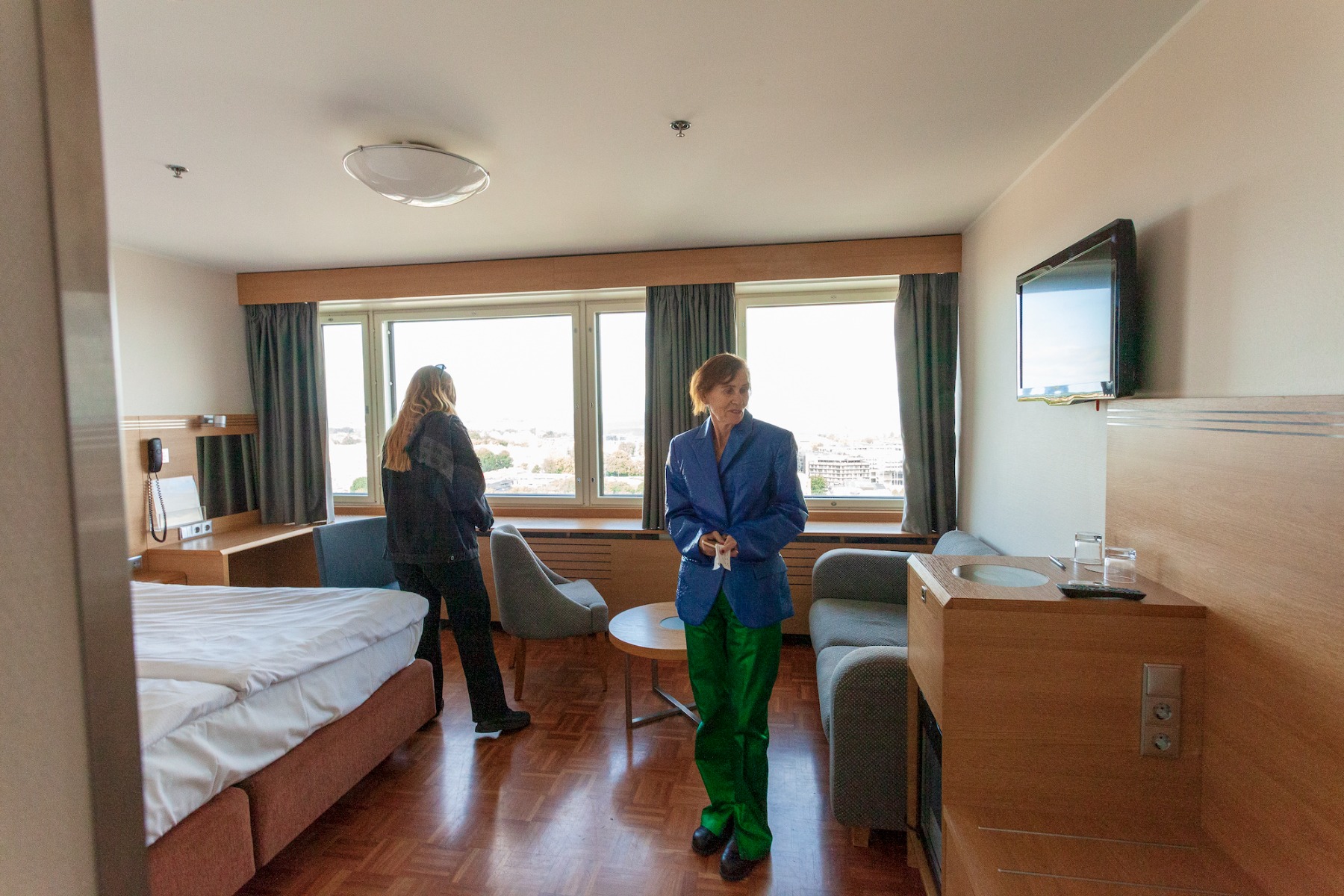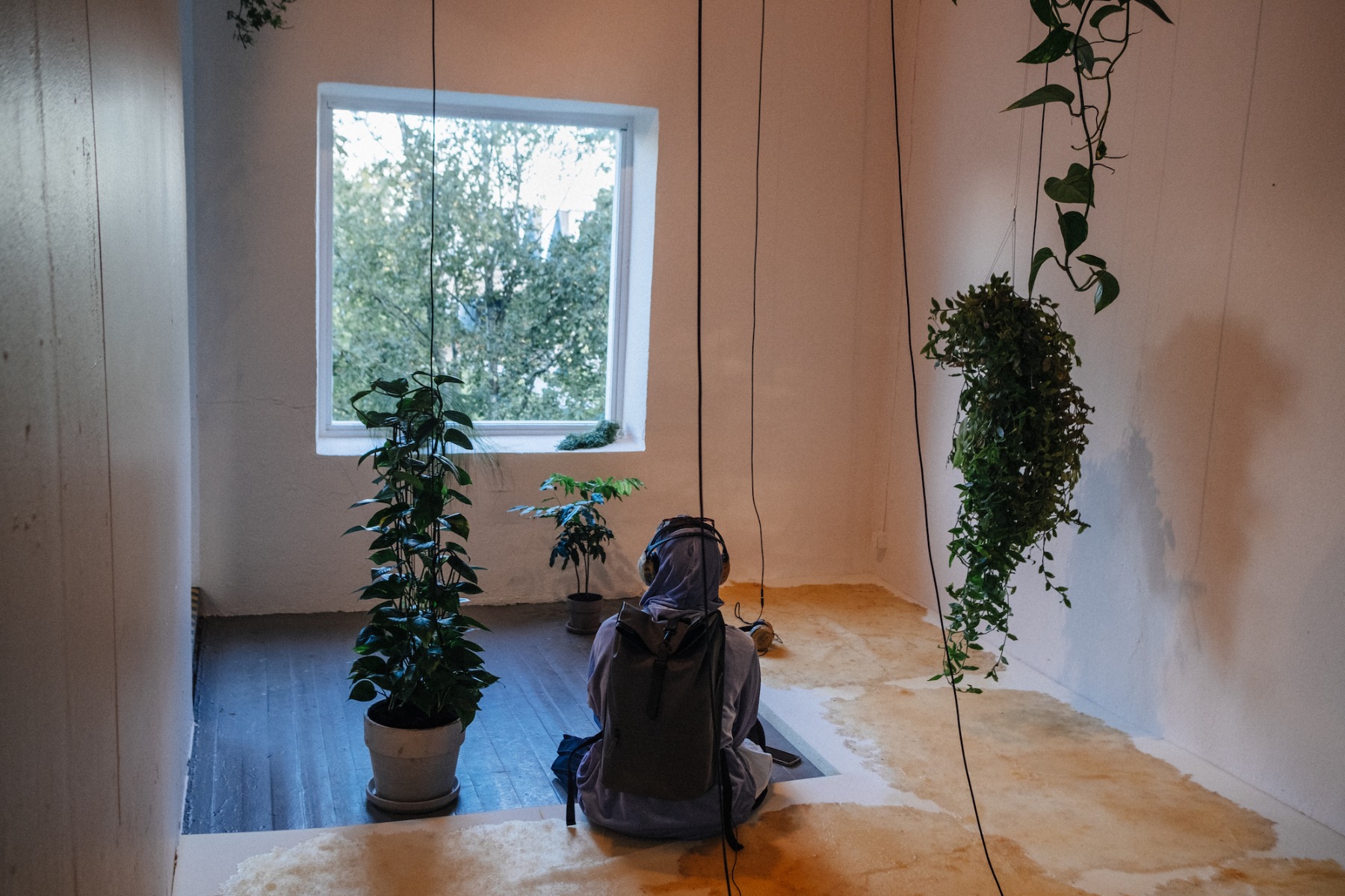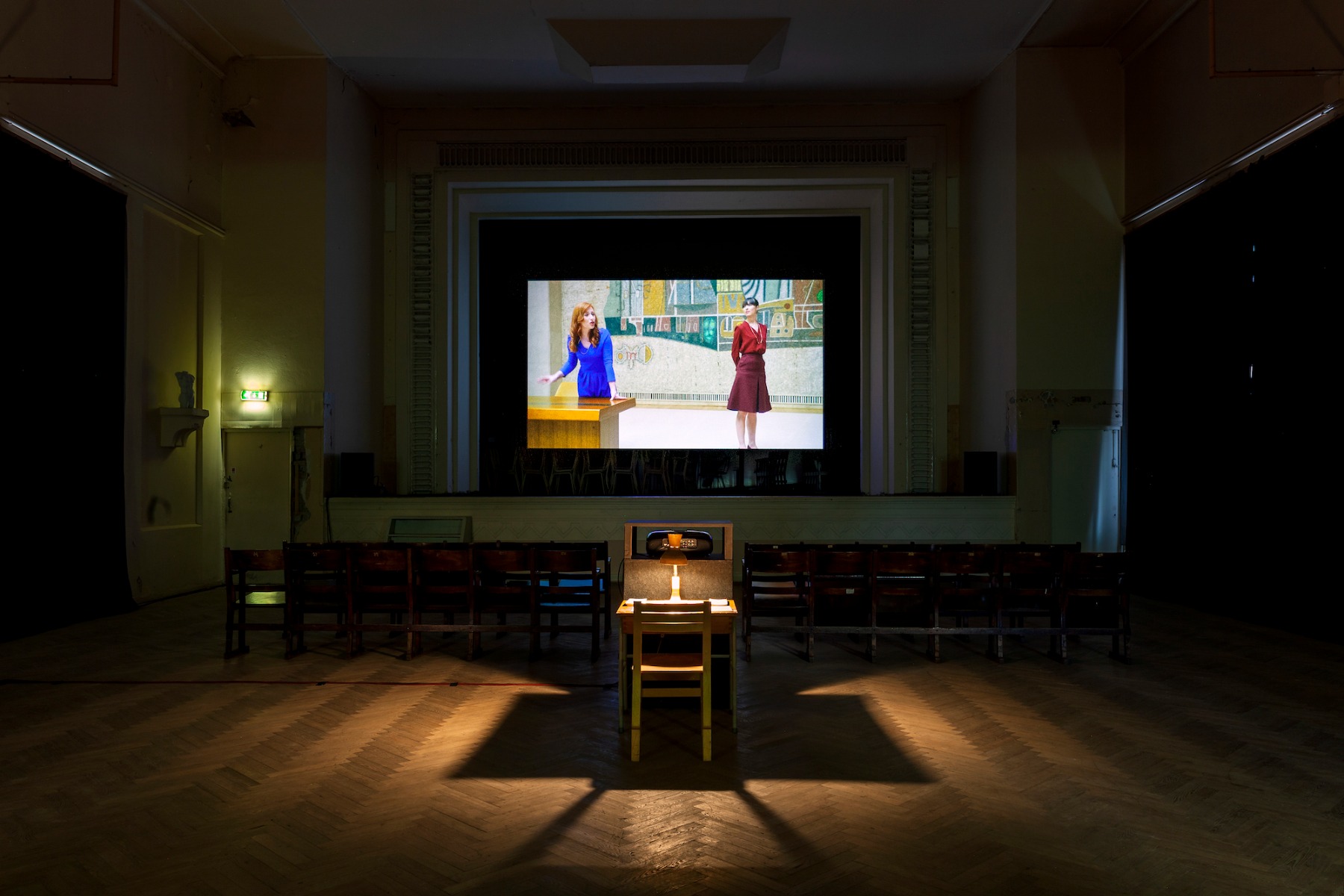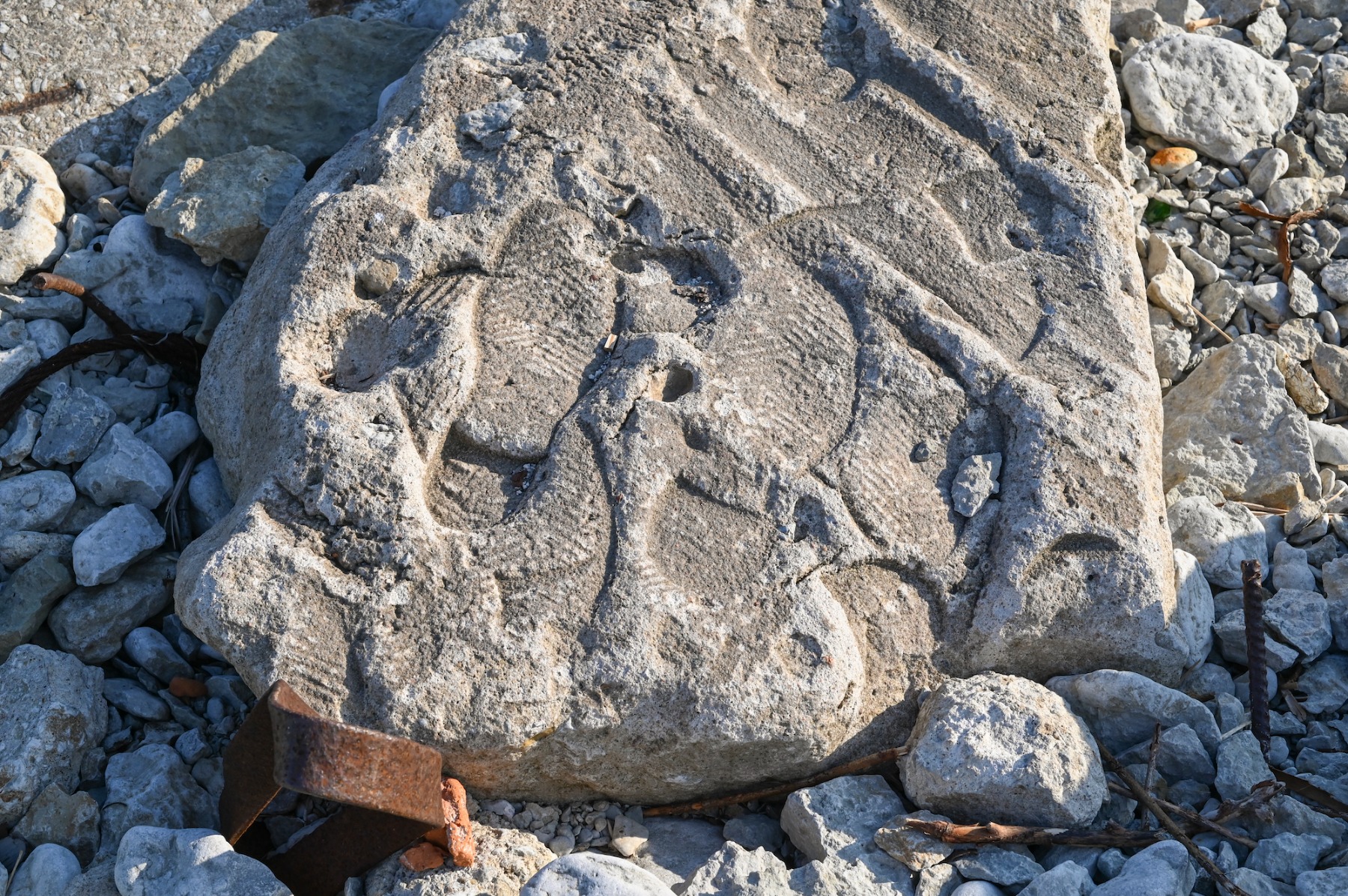
Empathy lessons on location
The main exhibition of the Tallinn Photomonth biennial of contemporary art is on view through 17 October 2021
Alongside the space of the Contemporary Art Museum of Estonia (ЕККМ), the main exhibition of the Tallinn Photomonth biennial of contemporary art has spread to a number of alternative venues ‒ iconic buildings of various eras and neighbourhoods of Tallinn and even the actual urban environment of the Estonian capital. The curators of the exhibition entitled ‘Intensive Places’ ‒ the TOK Creative Association of Curators (Anna Bitkina and Maria Veits) – have worked hard to identify locations of high topographic potential in Tallinn and then build a multi-layered dialogue between these spots, the artists and the viewers, at times giving preference to the agency of the place over an author’s interpretation.
Fragment of Anna Kaarma’s ‘Lasnamäe ‒ an audio expedition: Poetic meanings for a functional space’ (2021)
This year, the Tallinn Photomonth, initiated by the Estonian Union of Photography Artists in 2011, is marking its 10th anniversary. During this relatively short span of time, the Photomonth has evolved from a photography festival initially focusing on an art fair of professional contemporary photography into a solid biennial of contemporary art and visual culture, featuring a programme jam-packed with events and significant key exhibitions as well as diverse satellite shows ‒ their number exceeding a dozen and their venues located beyond the boundaries of Tallinn, passing on the photo-baton to Tartu Art House and Narva Art Residency.
Fragment of the exhibition at ЕККМ
Furthermore, a distinct conceptual division of objectives could be detected: while the Foto Tallinn 2021 art fair put an emphasis on the actual professional photography referred to by the name of the biennial, the key exhibition of the biennial ‘Intensive Places’ dealt with contemporary art and visual practices in the widest possible sense of the word. On one hand, the Tallinn Photomonth team retains its historical foundation, on the other ‒ takes into consideration the experience of huge ‘mono medium’ shows and remains open to a variety of art media. For instance, the oldest regular international exhibition in Estonia, the Tallinn Print Triennial, has evolved over the last decades from a review show of print from the Baltic countries into a strong curatorial exhibition featuring artists from every part of the world that retains its focus on multiples, multipliable images, as a sign of respect for the printmaking techniques of reproduction.
There are both benefits and risks to mounting an art medium-driven exhibition, and the Photomonth seems to be searching for a middle ground between two extremes: if the Foto Tallinn 2021 exhibition delighted with a show of masterfully executed conceptual and philosophically contemporary photography, the ‘Intensive Places’ project transported philosophy to not just artistic but also anthropological, cartographic, social and urbanistic practices. The point of departure for the TOK association was the concept of ‘intensive geography’ proposed by the Russian media researcher and philosopher Mikhail Kurtov to denote locations that possess a certain potential of ‘accumulation’ and ‘dispersion’ ‒ of people, artefacts, various processes. Exploring geography through a lens of the Anthropocene, TOK simultaneously attempted to embrace decolonisation, both on a political and humanistic level, to the extent of deconstruction of the anthropocentric worldview.
Inside the installation of Madlen Hirtentreu’s ‘Inn of the Accord’ (2021)
The role of the protagonist in the works on view in ‘Intensive Places’ is frequently played by a location or an environment. It is often achieved through a gesture of the readymade: the place becomes a found object transformed by the artist’s will into a part of his or her work. Thus, Madlen Hirtentreu’s ‘Inn of the Accord’ (2021) is a little tour of a room of the legendary Viru Hotel (now ‒ Original Sokos Hotel Viru): Mies van der Rohe-style minimalism, a very liberal design for the Soviet architecture, paradoxically merged here with sophisticated means of spying on foreign tourists ‒ a subject reminded of by the KGB Museum, also housed in the building. It seems bizarre that there used to be a high-rise building in the very heart of Tallinn that was closed to the locals, who were thus also robbed of access to the unique views of the Old Town and the new districts from its top-storey windows. Hirtentreu’s gesture, therefore, consists in inviting the viewers ‒ many of whom are residents of Tallinn ‒ to enjoy views that normally are not available to denizens and visitors of the Estonian capital. The interpretation and analysis by the artist here is significantly more ephemeral than the dynamically outlined ‘aura’ of the place, the experience of its pure presence.
Fragment of the exhibition at ЕККМ
Similarly, the building of the Contemporary Art Museum of Estonia (EKKM) became the central piece of the exhibition on view where individual works by different artists were interwoven into an integral whole while the space sounded like a seashell filled with the waves of the ‘Tabula’ site-specific sound installation (2021) by Alexander Morozov. The architectural object transformed into a musical instrument, its melody inspired both by the local musical traditions, including piano-building (the Estonia brand of grand pianos), and the somewhat complicated history of the EKKM itself. Founded in one of the abandoned buildings of the former Tallinn heat and power station practically by squatting, today this citizens’ initiative remains the final island of alternative culture in this territory that has been subjected to aggressive gentrification.
While viewing the works featured in ‘Intensive Places’, the visitor can choose to give preference to the gnoseological, cognitive or to the poetical, phenomenological aspect where personal experience takes the foreground. He or she can, for instance, watch all 65 minutes of the video that is part of the ‘Muse’ (2020) installation by Terike Haapoja and hear the stories that crystallise in the conversations between the characters ‒ ponder the question whether the artist has created a deliberate parallel between the title of her work and the location where the video was filmed. According to one of the dialogues, the role of a muse is to serve as an instrument of inspiration and imagination, inevitably losing her individuality through that. The conversation takes place against a background of footage of wonderful natural landscapes, and you cannot help being reminded that Earth and Nature are also of the feminine gender in the cultural context. However, the little island where the action is set, clearly becomes an active agent in creating the visual plane instead of remaining a scenery that loses itself in the main narrative. Which is the reason why it is absolutely fine for the viewer to enter the room for a couple of minutes, for a brief breather or meditation among other things. In the context of the majestic building of the National Library of Estonia, designed in the 1980s by the architect Raine Karp along the lines of a temple of knowledge, this moderately-sized room with the video seems like an oasis for taking breath between sessions of hard work among the books.
Still from Terike Haapoja’s video ‘Muse’ (2020)
Farther away from the city centre of Tallinn, the video ‘Tear Down and Rebuild’ (2015) by Jasmina Cibic makes great use of its venue, the former Kopli Folk House (cultural centre). The work is projected on a big screen in a cinema auditorium, offering a detailed display of the grand interior of the former Palace of the Federation in Belgrade, juxtaposing it with the local ‒ but also quite stylish ‒ room. This ‘space within space’ works both on an artistic and a political level, provoking thoughts of the fate of the Folk House building (local activists are currently attempting to give it a new lease of life). Erected in the 1930 in what used to be Tallinn’s industrial district, it is a remarkable synthesis of functionalism and traditionalism. Designed to form an integral whole with the garden that surrounds it, the building reflects the ideals of new urban planning, which, alongside dwelling and industrial structures, also presumes creating quality communal architecture and public spaces that would facilitate active cultural and social life.
The discussion among the female characters of Cibic’s video work ‒ Nation Builder, Pragmatist, Conservationist and Architect – is a collage of quotes by politicians, philosophers, architects, in favour of both preservation and demolition of historical architecture. The previously aired ideas merge into a brand new text, highlighting the never-ending debates in which the categories of beauty and the general good are balanced with arguments prioritising functionality, benefit and profit. Will the not-so-functional-any-more yet still impressive Kopli Folk House manage to become a monument to historical processes and simultaneously a centre for the cultural life of the new neighbourhood communities? Time will show.
A walk in the Lasnamäe district ‒ the main subject of work by Anna Kaarma. Photo: Roman-Sten Tõnissoo
The most distant among the ‘exhibits’ of the show is Anna Kaarma’s ‘Lasnamäe ‒ audio expedition: Poetic meanings for a functional space’ (2021). The sizeable ‘bedroom suburb’ of Lasnamäe, designed and built during the decline of the Soviet empire, embodies the utopia of Soviet communal urbanism and, at the same time, a post-Soviet dystopia ‒ the anonymity and alienation that encompasses mass standardisation. The audio tour by Kaarma, devised in association with the writer Jan Kaus, offers three different routes that uncover different facets of Lasnamäe: its natural and historical aspects, its contribution to the art life and development of architecture of the time, its role in the cultural context of Estonia ‒ from painting and literature to filmmaking. These tours undoubtedly can be of interest not just to tourists and residents of other districts of Tallinn but also to the local people of Lasnamäe as an invitation to take a look at their everyday environment through different eyes, becoming aware of the value and significance of this part of the city which, sadly, is currently being predominantly neglected.
A view of the exhibition featuring video work ‘Tear Down and Rebuild’ (2015) by Jasmina Cibic
The radical shake-up in the world caused by the current pandemic is forcing us to review our familiar values, routines and way of life. For many of us, one of the numerous newly acquired habits that saved us during the chaotic and troubled times of lockdown was walking – both in nature and in urban environment. These walks help us rediscover places that used to seem so familiar, take a more mindful look at the objects we encounter on our well-trodden paths ‒ either critically or, quite the opposite, discovering in them new valuable aspects, from historical to aesthetic ones. Attention to narratives hidden in our everyday environment, an opportunity to de-/re-code them are a major skill in a world where freedom of movement still remains somewhat limited for the time being. The curators from the TOK association seem to have become aware of the potential of this routine practice, attempting to transfer it to the audience of their exhibition ‒ including as a possible strategy of re-evaluating the basic models of (collective) existence, the necessity for which has been made obvious by the current pandemic crisis.
From ‘How to Move Like a Slime Mould’ by Laura Kuusk, 2021
Alongside the corona-crisis, the TOK curators are obviously interested in problems related to the global environmental and human crisis. The objective stated in the curatorial concept ‒ search for an answer to the question of how to prepare for a future where interdependence and peaceful coexistence of different organisms is practiced ‒ can be redefined, among other things, as a lesson of ultimate empathy. The audience of the ‘Intensive Places’ projects can embrace ‘an insider’s view’, taking a look at the world through the eyes of a different community/society or a non-human living organism ‒ from the macrocosm of a city neighbourhood (‘Lasnamäe...’ by Anna Kaarma) to the microcosm of Mycetozoan cells (‘How to Move Like a Slime Mould’ by Laura Kuusk, 2021). According to contemporary scientists and philosophers, the human race can only save itself and our planet with all its inhabitants through overcoming its fundamental anthropocentrism. And methods of doing that are offered by art, allowing ‘trying on’ alternative vantage points and even playing out different scenarios of unfolding events.